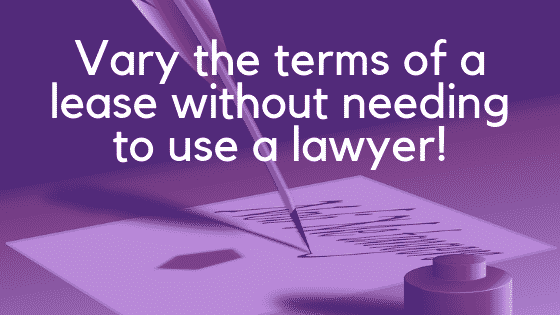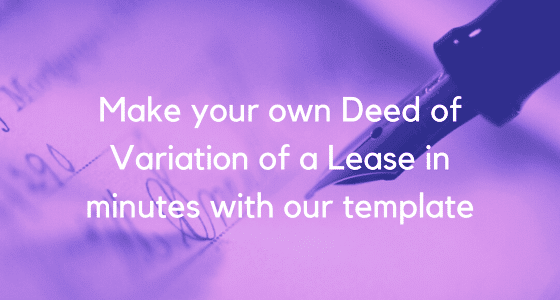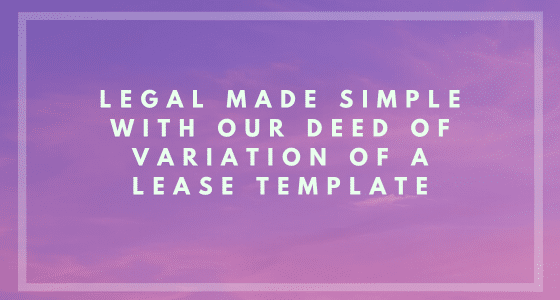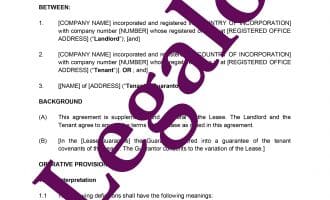Deed of Variation for a Lease
Our Deed of Variation for a Lease Template:
- Vary commercial or residential leases with this template
- UK-expert-drafted for your peace of mind
- Easy to customise
- Full guidance notes for easy editing

How Does It Work?
-
1. Download
-
2. Edit
-
3. Print
-
4. Sign
You can use this deed of variation for a lease template to vary the terms of a lease of a property in England and Wales. Not for use for property situated in Scotland, as property law in Scotland is different.
When to use our template
For the terms to be legally varied, both the landlord and the tenant must agree to the variation and sign a Deed of Variation to make the amendment binding. Our template comes with optional clauses, meaning it can be used whether or not the lease:
- is a commercial lease or a long residential lease;
- has been registered with the Land Registry;
- has a third party guaranteeing it;
- (for a commercial lease) is classed by the Landlord and Tenant (Covenants) Act 1995 as a “new” or “old” lease; or
- (for a commercial lease) includes a right for the business tenant to ask to extend the lease when it expires (“security of tenure”).
An example of when you might use this deed of variation is if the tenant of a residential long lease wants to extend the lease and the landlord agrees. You can use this template for that. You would vary the original term of the lease in order to extend it, pay the landlord the fee (or “premium”) that it wants to charge for this. Generally, this does not cause extra SDLT to be payable, but you will need to check this yourself.
Adding land while varying the lease?
Where you want to vary the lease to grant the tenant a lease of a new site or additional building (or part of one), it is better to issue a fresh lease. We have a commercial lease template available for this. Our guide to the deed of variation also explains about this if you want to read more.
Surrendering part of the land while varying a lease?
Where the variation is to surrender part of the site, instead you should use a deed of surrender (please see our deed of surrender of lease template for this), and if there are any other changes to the remaining site, then use this deed of variation for that remainder.
Using this Deed of Variation template
David, our co-founder and experienced solicitor, drafted this template. It is easy to edit and complete, whilst legally comprehensive. Our guidance notes provide step-by-step instructions on editing the Deed and make completing the final document simple. A copy of the guidance notes are available here: guide to this deed of variation for a lease template.
Download this template in Word format at the click of a button once purchased. You can then easily edit it to suit your own situation.
We provide a full money-back guarantee in case you are not happy with your template document for any reason.
Once purchased, you can reuse the template as many times as you want. You can then create further deeds of variation at no further cost. We keep our templates under review to ensure they are up-to-date. When we update a template that you have bought, we will notify you by email and we will give you free access to the updated template.
If you would like to see our other commercial property templates click on the link.
Registering the Deed of Variation at the Land Registry
For the Land Registry’s guide on how to register the deed of variation once signed, click on this link and then scroll down to the heading, “2.2 Use of deeds of variation”. Follow the instructions on their website as to how to deal with this. They have their own helpline if you need assistance.

FAQs on a deed of variation
Below, we answer the top questions on this topic from the Internet.
What is a deed of variation for a lease?
A Deed of Variation for a lease is a legal document used in the UK to make changes to the terms of an existing lease agreement. It can be used for both commercial and residential property. It allows leaseholders and landlords to change aspects of the lease, such:
- as extending the term;
- altering rent provisions; or
- adjusting other contractual conditions.
This document is often used to accommodate changing circumstances or resolve disputes related to a leasehold property, providing a formal and legally binding means of amending the lease agreement.
Can I write a deed of variation for a lease myself?
While you can draft a deed of variation for a lease yourself, you really need a solid starting point like a template, otherwise you will just waste time and be frustrated in trying to “re-invent the wheel”. This is why we recommend starting off with our deed of variation for a lease template, which you can download from Legalo quickly and easily. All you need to do is fill in the details!
How much does a deed of variation for a lease cost in the UK?
For drafting a deed of variation for a lease, a high street solicitors firm will charge on average around £750 plus VAT. With our template, you can draft an agreement yourself for just £24.95.
How do I register a deed of variation of lease?
The process of registering a deed of variation of a lease with the land registry involves these steps:
- Obtain a copy of the Deed of Variation, signed by all relevant parties.
- Complete an Application to Change the Register (Form AP1).
- Pay the appropriate Land Registry fee.
- Send the Form AP1, the Deed of Variation, and the fee to the Land Registry by post or electronically through the Land Registry portal.
- The Land Registry will process your application, and once approved, they will update the property’s register to reflect the changes made in the Deed of Variation.
- You’ll receive a new official copy of the register showing the updated information.
Do I need a solicitor for a deed of variation?
It is not legally required to hire a solicitor for a deed of variation for a lease, so you can draft and complete the agreement yourself with the help of our template, eliminating the high expenses of a solicitor. With a Legalo template, you can ensure the document is:
- legally sound; and
- includes everything you need to draft a binding agreement.
Who pays for a deed of variation for a lease?
The party responsible for paying for a Deed of Variation for a lease varies depending on the specific circumstances and negotiations between those involved. It can be the leaseholder, landlord, or a shared cost, depending on the agreed upon terms. Usually, the party requesting the modification covers the associated legal and administrative expenses. However, this is subject to negotiation and the nature of the changes you are making. The existing terms of the lease may also affect this.
How long does it take to write a deed of variation?
The time it takes to draft a Deed of Variation for a lease can vary significantly depending on several factors, including the complexity of the changes, the cooperation of all parties involved, and the workload of any legal professionals assisting you. In some straightforward cases, it might be possible to draft the deed in a matter of days or weeks. However, more complex modifications or negotiations can extend the timeline to several weeks or even months.
What is an alternative to a deed of variation?
An alternative to a deed of variation for a lease is the execution of a lease addendum or lease amendment. Rather than creating an entirely new document, a lease addendum or amendment is a separate agreement that modifies specific terms or provisions of the original lease. This allows you to make changes to the lease, without requiring a complete overhaul or re-execution of the entire document.
Who benefits from a deed of variation for a lease?
A deed of variation for a lease generally benefits both the landlord and the tenant. It allows for mutually agreed-upon changes to the lease terms, providing flexibility and addressing specific needs or circumstances that may have arisen since the parties initially signed the lease. Landlords can use it to:
- adjust rent;
- extend lease periods; or
- make other modifications.
Tenants can seek changes to accommodate their changing requirements. Commonly this is done to extend the term of a residential lease.
Do I need a deed of variation for a lease?
Whether or not you need a deed of variation for a lease depends on the specific circumstances and the nature of the changes you wish to make to the lease agreement. Generally, you would use a deed of variation when there is a need formally and legally to modify the terms of an existing lease. If the changes you want to make to the lease are substantial or involve fundamental aspects of the lease, it is advisable to use a deed of variation. This document ensures that the changes are legally binding and provides clarity for all parties involved. On the other hand, for minor or straightforward changes that do not significantly impact the core terms of the lease, a separate agreement or addendum may suffice.
Can a deed of variation for a lease be refused?
Yes, a landlord can refuse a deed of variation for a lease, but it depends on the specific circumstances and the willingness of the parties involved to agree on the proposed changes. If either the landlord or the tenant is not willing to accept the variations, they will not sign the deed. So then the lease terms will remain as they were. It’s important for both parties to negotiate and agree upon any modifications to the lease terms. If the parties cannot reach an agreement, the existing lease terms will continue to apply.
Is a Deed of variation for a lease legally binding?
Yes, a Deed of Variation for a lease is legally binding when properly executed in accordance with the applicable legal regulations. It is a formal legal document that amends the terms of an existing lease. Once signed by all relevant parties, it holds legal weight.


